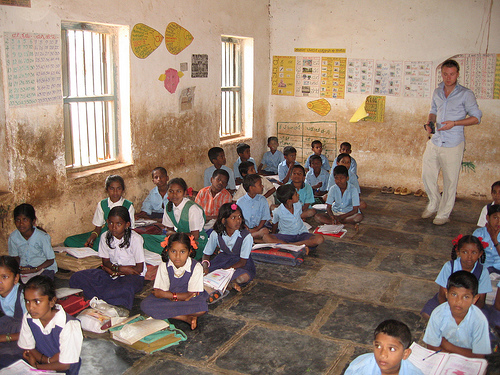
It was really thrilling to be invited to represent the educational part of a recent White House delegation to India, led by White House CTO Aneesh Chopra and Alec Ross, senior adviser for innovation to Secretary of State Hillary Rodham Clinton.The trip was quite informative for me, since I have not kept up with the educational system in India.

An Indian Classroom
Use of Resources
To be honest, I was expecting the “same old same old” list of complaints… we don’t have enough resources, our teachers don’t show up or aren’t truly present in the classroom, our students are not interested, etc.But what struck me the most was the use of resources:when there are resources, they are not being used in a very productive way.For the most part, the funds are not being spent where most needed. And this is true for even the USA. Its quite striking that the problems are the same all over.
For example, we visited a slum area where the children had very little – almost no home, no food and no toilets. So when I went to see the broken down, falling apart red brick school house, I was shocked to see nice wooden desks and chairs crowded around in small areas.Now I ask you, would the students rather have nice wooden desks or food to eat so that they can apply their minds? Or even have the proper clothes to wear for the weather conditions?Who decided that having nice wooden desks and chairs was the most productive use of the money that was donated for these students?
On the other end of the spectrum, I visited a private school where the focus was all about critical thinking and incorporating creativity into the rigor of education (I don’t necessarily think that rigor has a negative connotation).The group talked about the idea that learning multiplication tables is good because by using the multiplication tables, you don’t waste your time and energy calculating the fact, freeing you up to move on to more important findings.It was very refreshing to sit in an auditorium talking to a group of students and teachers who all gathered voluntarily on their own time to share their thoughts and ideas.The students were clearly quite motivated with high aspirations, and all possessed creativity and a strong work ethic.These were privileged students who want to impact the world. The students were very motivated to find places to apply their strengths and wished to change the world.

A US Classrrom
Delivery of Content
The trip also underscored for me that one of the most difficult issues we have to deal with is the “last mile delivery of the content” – how to get educational material into the hands of the most in need students.This is a challenge in the U.S., as well as in India and other countries across the globe.This challenge is complicated because the cost is high.All delivery systems, whether print or technology-based, are expensive to provide for all students.A lack of resources and the absence of IT infrastructure further complicate the issue.
Also complicating the issue – the “not invented here” syndrome, which exists in India and the U.S.This syndrome is represented by the following objections:
- This content does not work for me as I need content for my State
- My district needs to approve this content
- Content provided by organizations that are not from my backyard cannot possibly create it for my students
- My school does not approve of “non-publisher” produced content
I ask you how does content differ from place-to-place. Isn’t 2+2=4?
Engaging Students
But even if the materials we look to disseminate were successfully delivered, I think about the students in the slum and I ask myself:What is the relevance of the material to them?Do they comprehend the content?How can we make it such that they can do something with the content that we expect them to use?Are we using “to be educated” with a common meaning?
Perhaps the biggest challenge is the fact that our students are not interested in the way that we are educating them today.
In the end, the teachers I met in India expressed it most eloquently, “We need help.Not money but professional development and professional collaboration.”
Collaboration
We have more data and research in the U.S. than most other countries.Educators worldwide want opportunities to “hone their skills.” Prehaps that is something we can use this as the starting point to do together.By collaborating with our peers in other countries, we can combine our intellectual resources and rigor, our creativity, our desire to engage, and our critical thinking to overcome our common obstacles.We must engage our peers to arrive at the solutions we all seek.

